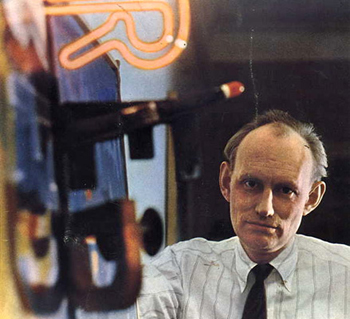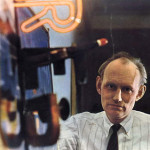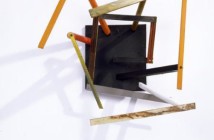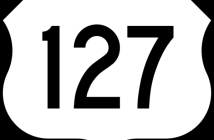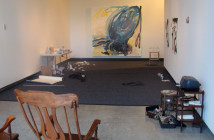9 Evenings Reconsidered: art, theatre, and engineering is a sprawling exhibition centered around a major collaborative effort that transpired in 1966. As the catalog and the curators make clear, to reconsider these 9 evenings is not only a problem of presentation, but also of gathering pertinent archives and residue that can inform what actually occurred 40 years ago. Indeed, as I walked through the exhibition, watched the subsequent films, read the catalog, and listened to the curators, it often remains blurred what the precise results of these collaborations actually were. Am I watching documentation? Are the many diagrams meant as products from the events, or are they of the pure instructional variety? What about that outmoded equipment on the pedestal? What is spectacular was the belief that the inter-disciplinary approach to this event could foster new understandings for not just art, but life.
A brief history of the parameters that governed these events goes something like this: The collaborative efforts of ten respected artists from several disciplines (painters, dancers, musicians) got together with some thirty engineers who volunteered their time from Bell Laboratories. Billy Kluver orchestrated the whole endeavor and chose very accomplished artists whom most know today: Robert Rauschenberg, David Tudor, John Cage, Yvonne Rainer, Steve Paxton, Robert Whitman, Oyvind Fahlstrom, Alex Hay, Deborah Hay, Lucinda Childs. Artists were given ample funding along with access to the most advanced technology (along with people who knew how to make it work) to produce a performance/theatre event within their own artistic sensibilities. Nine long months of arduous work and collaborations resulted in 9 evenings of, well, some very messy performances. As the catalog indicates, many left the performances feeling disappointed, especially the critics who wrote appalling reviews. The many engineering defects, long dead spaces between pieces and sometimes in the middle of them were just a few of the noted problems. Subsequent photos and documentation, as well as efforts to reclaim these events from critical failure (including this exhibition) have resurfaced in recent years.
The phenomenal efforts by all involved to create an avant-garde production that was truly inter-disciplinary and collaborative should not go unnoticed. Some works, like Robert Rauschenberg’s playful tennis game, continued on a tradition of fluxus actions and are easier to describe. Electrified rackets (which are on display in a plexi-glass case at the List Center) created bings and bongs when they hit the ball and initiated lighting to deplete with each hit. The game ended with some wonderfully creepy shots of a crowd watching a blacked out tennis game, as one can see from the documentation video. John Cage’s piece is in line with much of his other works. ForVariations VII he made use of a sound system designed by his set of engineers that extrapolated sound from over 50 sources including a juice blender, fan, toaster, radio stations, two television channels, oscillators, a pulse generator and ten telephone lines open to various locations in New York City. In typical Cage fashion, he allowed the time during his performance to dictate the results, opting for chance and allowing technical difficulties to even become part of the music.
But I digress. To outline all of the performances and describe each artists intentions and results is better left to people who have studied these events with more rigor (Catherine Morris and Bill Arning are the best) As I mentioned in the beginning of this review the fruits of these collaborations are often difficult to decipher, in part because the approach to each performance/event was NOT product orientated, nor was documentation a primary goal. In an essay by Brian O’ Dougherty printed in the catalog he mentions that a similar exhibition was in the planning stages before 9 evenings. This Dutch venue, however, was insistent that a clear separation between the engineers and artists remained. In 9 evenings, this separation is never tidy, making the collaborations and the documentation “messy” and opaque. There is a certain comfort level that must be abandoned when attending this exhibition for precisely that reason. I became very aware of my own desire and expectation to know who the author was and that the product of his/her clear intentions was on display. This is not the result of 9 evenings. Yet, what replaces the cleanliness of authorship is the beautiful confusion that happens in collaboration, a confusion artists working today should take note of.
It occurred to me the massive technological events that happen today in the art world are rarely billed as collaborative efforts, instead promoting the singular vision by only the “artists” (even collaborative teams take the identity of a single vision that seems contradictive to the whole process- see Assume Vivid Astro Focus or Forcefield). The complicated video and sound installations by Doug Aiken and the team of Janet Cardiff & Georges Bures Miller are only a few of the technological masterpieces of our time. Yet, the many people involved to make these pieces happen are rarely recognized. It does seem clear the art world prefers the division of labor between “artist”, “technician”, “engineer” and “worker”, a division that 9 evenings thought to dismantle and collectively make complicated and beautifully utopian.
Links:
MIT List Visual Arts Center
"9 Evenings Reconsidered: Art, Theatre, and Engineering, 1966 " is on view from May 4- July 9th, 2006 at the MIT List Visual Arts Center.
Image found online.

